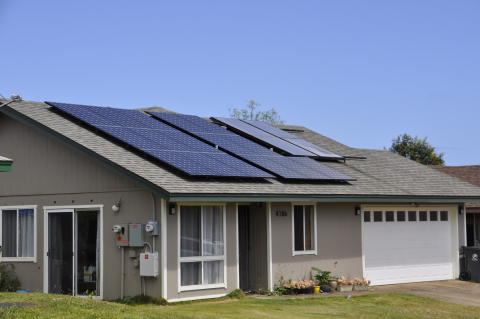KIUC Business Hours: Monday - Friday, 8 a.m. - 4 p.m. (excluding holidays)
Curtailment FAQs
As your electric cooperative, KIUC is your source for energy and information. Interest in solar power continues to grow as residents and businesses look to save money and support renewable energy.

KIUC frequently has more solar resources feeding into the grid than it has load during sunlight hours. When the amount of solar exceeds the demand for energy, KIUC must reduce the amount of solar energy feeding into the grid. This is called curtailment, and it potentially impacts KIUC’s Schedule Q customers who have installed an “oversized” system. Oversized systems generally produce significantly more electricity than is needed to meet the household’s average daytime energy demand. As part of their interconnection agreement, these customers were required to install a separate curtailment meter, and are therefore subject to curtailment. The below chart specifies the maximum size PV system, based on average monthly usage, in order for the system to be “right sized” and to avoid having to install a curtailment meter upon interconnection.
Right-Sizing Criteria
| Average Monthly Usage in kWh | Maximum PV Size |
| 0-500 | 2.5kW |
| 500-800 | 2.75 |
| 800-900 | 3.00 |
| 900-1000 | 3.5 |
| 1000-1100 | 3.75 |
| 1100-1200 | 4.25 |
| >1200 | 5.25 |
KIUC’s rights are consistent with its obligations, which in regards to interconnecting non-utility power generating resources, is the requirement that KIUC maintains a safe, stable, and reliable electric grid. This is important to ensure that all of KIUC’s members receive quality power service. To meet this obligation, KIUC has the right to place conditions on customer interconnections if a customer desires to interconnect with KIUC’s grid. KIUC’s curtailment policy was implemented in November 2015 and is part of each customer’s interconnection agreement if they applied for a new system, added to their existing system, or made a change to their system after that date. A curtailment meter was required only if PV size was above the calculated “right size” for their home at that point in time (see table above). A copy of the standard interconnection agreement is attached with the appropriate sections highlighted in yellow.
Our current interconnection agreement includes a condition requiring that the interconnecting customer grants KIUC the right to curtail a customer’s system (if it is larger than the specified “right size”) in exchange for KIUC granting the customer the right to interconnect with KIUC’s grid. The specific language in KIUC Schedule Q Modified Agreement, Exhibit 1 states, in relevant part, “Notwithstanding anything to the contrary, the Eligible Customer-Generator’s generating facility may be temporarily disconnected from KIUC’s system during periods of high solar penetration on KIUC’s system and as deemed appropriate by KIUC to ensure overall reliability of its system.”
The customer is required to install a curtailment device and accept the condition stated in their Schedule Q/Interconnection agreement in order to be given the approval to interconnect with KIUC’s grid.
As specified in the agreement, the member who wishes to oversize his/her system must install a separate meter specifically for the purpose of curtailment of the solar generating facility. If curtailment is necessary, KIUC will use a wireless meter to send a signal that will turn off the member’s rooftop system via the curtailment meter. KIUC will turn the system back on when the curtailment period is over.
It is necessary for KIUC to curtail solar resources when the energy generated by solar exceeds the demand for electricity on the grid. One trigger would be sunny, cold weather conditions, when solar is in abundance and load is generally lower than normal. However there are any number of circumstances where there is an imbalance of available load and renewable generation levels which can vary greatly.
In addition to residential and commercial rooftop systems, KIUC may also choose to curtail its own utility scale solar fields, the Green Energy Team biomass plant, the solar-plus-battery storage facilities owned by Tesla and AES, or several of our fossil-fuel generation plants.
Those decisions are made on any given day depending on a number of factors, the most important of which is maintaining a reliable and safe dispatch of power to the grid. Other factors include minimizing cost to members (i.e. curtailing the most expensive source of power versus the least expensive), maintaining adequate response capabilities based on the expected duration of the curtailment event, and insuring that enough “spinning reserve” is available to cover the single largest generator on line at any given time.
KIUC does not automatically curtail any of its solar resources “first” when the need for curtailment arises. Please see the answer to the previous question for a better understanding of the factors that are considered when curtailment is necessary.
It is best to consult with your solar contractor on options available. Options could include splitting your system or adding a battery for energy storage.
We encourage members who have questions about their interconnection agreement and curtailment to contact us directly. They may also work with their solar contractor for any options that would minimize the impact of curtailment.
